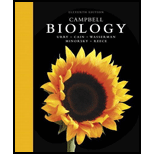
Describe how the parts of an ovule (integument. megaspore, megasporangium) correspond to the parts of a seed
To describe: The way in which the parts of an ovule such as integument, megaspore, and megasporangium develop into the corresponding parts of a seed.
Introduction: The ovule in the female plant contains a single or a double layer of the diploid integument (2n). The megaspore cell is haploid (n) inside the ovule. The tissue megasporangium (2n) is present inside the ovule. The fertilization of the ovule by the sperm leads to the formation of the diploid zygote. It forms the seed ahead.
Explanation of Solution
The integument is the outer layer of the ovule in the female, which is diploid (2n). The megaspore cell is haploid inside the ovule. The tissue megasporangium inside the ovule is diploid (2n). The haploid (n) sperm cell enters the ovule through the pollen tube and fertilizes it. This leads to the formation of the fertilized diploid zygote in the plants like angiosperms and the gymnosperms. The other two haploid cells are fertilized by the other sperm to form the triploid (3n) cell containing the endosperm. This leads to the formation of the complete seed. The seed contains the fertilized ovule inside. The development of the seed takes place to form the seed coat, spore wall, and the inner tissue that supplies the food and nutrition.
The fertilization of the female ovule (n) takes place by the help of the male haploid (n) sperm. This leads to the formation of the diploid fertilized zygote (2n). The zygote then grows to form the seed containing the nutritious tissue, which provides the food and water. The other two haploid cells inside the ovule get fertilized by the sperm cell to form the triploid cell inside the ovule. This forms the complete seed in the plants.
Want to see more full solutions like this?
Chapter 30 Solutions
Campbell Biology (11th Edition)
- When beta-lactamase was isolated from Staphylcoccus aureus and treated with a phosphorylating agent, only the active site, serine was phosphorylated. Additionally, the serine was found to constitute 0.35% (by weight) of this beta-lactamase enzyme. Using this, calculate the molecular weight of this enzyme and estimate the number of amino acids present in the polypeptide.arrow_forwardBased on your results from the Mannitol Salt Agar (MSA) media, which of your bacteria were mannitol fermenters and which were not mannitol fermenters?arrow_forwardhelp tutor pleasearrow_forward
- Q8. A researcher wants to study the effectiveness of a pill intended to reduce stomach heartburn in pregnant women. The researcher chooses randomly 400 women to participate in this experiment for 9 months of their pregnancy period. They all need to have the same diet. The researcher designs two groups of 200 participants: One group take the real medication intended to reduce heartburn, while the other group take placebo medication. In this study what are: Independent variable: Dependent variable: Control variable: Experimental group: " Control group: If the participants do not know who is consuming the real pills and who is consuming the sugar pills. This study is It happens that 40% of the participants do not find the treatment helpful and drop out after 6 months. The researcher throws out the data from subjects that drop out. What type of bias is there in this study? If the company who makes the medication funds this research, what type of bias might exist in this research work?arrow_forwardHow do I determine the inhertiance pattern from the pedigree diagram?arrow_forwardits an open book assignemntarrow_forward
- Describe two different gene regulation mechanisms involving methylationarrow_forwardWhat is behavioral adaptarrow_forward22. Which of the following mutant proteins is expected to have a dominant negative effect when over- expressed in normal cells? a. mutant PI3-kinase that lacks the SH2 domain but retains the kinase function b. mutant Grb2 protein that cannot bind to RTK c. mutant RTK that lacks the extracellular domain d. mutant PDK that has the PH domain but lost the kinase function e. all of the abovearrow_forward

 Concepts of BiologyBiologyISBN:9781938168116Author:Samantha Fowler, Rebecca Roush, James WisePublisher:OpenStax College
Concepts of BiologyBiologyISBN:9781938168116Author:Samantha Fowler, Rebecca Roush, James WisePublisher:OpenStax College Biology: The Dynamic Science (MindTap Course List)BiologyISBN:9781305389892Author:Peter J. Russell, Paul E. Hertz, Beverly McMillanPublisher:Cengage Learning
Biology: The Dynamic Science (MindTap Course List)BiologyISBN:9781305389892Author:Peter J. Russell, Paul E. Hertz, Beverly McMillanPublisher:Cengage Learning Biology 2eBiologyISBN:9781947172517Author:Matthew Douglas, Jung Choi, Mary Ann ClarkPublisher:OpenStax
Biology 2eBiologyISBN:9781947172517Author:Matthew Douglas, Jung Choi, Mary Ann ClarkPublisher:OpenStax





